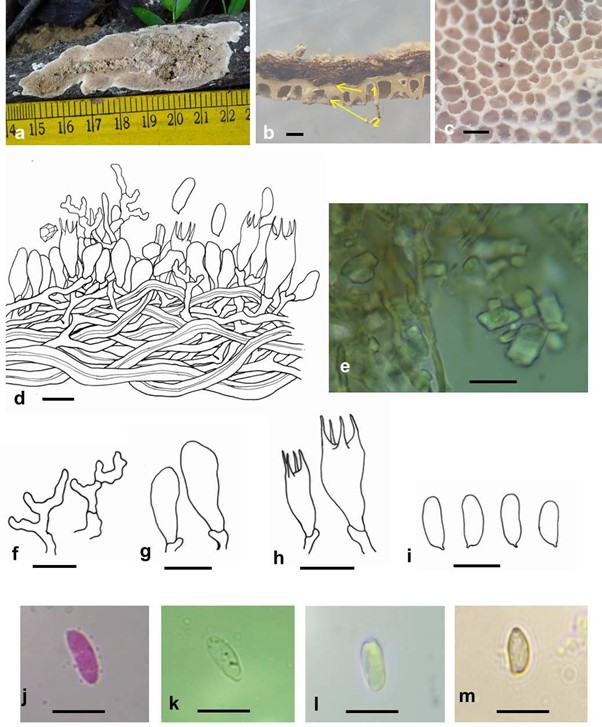Megasporoporia tamilnaduensis Kezo, K., Kaliyaperumal, M. & Gunaseelan, S., sp. nov.,
MycoBank number: MB 559790; Index Fungorum: IF 559790; Facesoffungi number: FoF 12713 Fig. 1
Etymology: “tamilnaduensis” refers to the place of collection.
Holotype: MUBL4022
Description: Basidiocarps annual, resupinate, without odor or flavor when fresh, becoming corky upon drying, up to 9 cm long, 2.5 cm wide and 1.5 mm thick at the center. Margin white (5A1) when fresh becoming yellowish white (4A2) on drying, up to 0.5mm wide. Pore surface reddish white (7A2) when fresh to brownish grey (6C3) on drying; pores round to angular, 1-2 per mm; dissepiments thin. Context duplex without black line, yellowish white (4A2) towards substrate, white (5A1) towards the tube, up to 0.5 mm thick. Tubes concolorous with the pore surface concolorous, up to 1 mm long.
Hyphal system dimitic, Skeletal hyphae dominant in context, while in trama generative hyphae. Context Generative hyphae, thin to thick walled, hyaline, clamped septate, branched, 2 – 3 μm diam., CB+, IKI ̄; Skeletal hyphae, thick walled with narrow lumen, unbranched, aseptate, 2.5 – 6.2 μm diam., CB+, IKI ̄. Trama Generative hyphae, thin walled, hyaline, clamped septate, branched, 1.8 – 2.5 μm diam., CB+, IKI ̄; Skeletal hyphae, thick walled with narrow lumen, aseptate, unbranched, 2.5 – 6 μm diam., CB+, IKI ̄. Tetrahedric to polyhedric crystals frequently present in the hymenium. Cystidia and Cystidioles absent. Dendrohyphidia present, 1.8 – 2.7 μm diam. Basidioles clavate, 14 – 20 × 7 – 7.8 μm. Basidia clavate, with four sterigmata, 16 – 24.2 × 7 – 8.2 μm. Basidiospores cylindrical, hyaline, thin-walled, (9.5-) 9.7 – 11.5 (-12) × (3.3-) 3.5 – 4 (-4.2) μm (n = 30/2), Q = 2.85; CB ̄, IKI ̄.
Specimen examined: INDIA, Tamil Nadu, Thiruvannamalai district, 12°29’15.4″N 78°55’01.8″E on dead wood, 14th November, 2019, Kezhocuyi Kezo (Holotype, MUBL4022).
Additional specimen examined: INDIA, Tamil Nadu, Thiruvannamalai district, Jawadhu hills, Nallapathur Reserve Forest, 12°32’49.9″N 78°54’05.9″E, on dead wood, 14 January 2020, Kezhocuyi Kezo, (Isotype, KSM-NP7 ).
GenBank numbers: ITS: ON249127 LSU: ON254196
Notes: Megasporoporia tamilnaduensis (MUBL4022) share similarities with M. bannaensis (Li and cui, 2013) by sharing annual, resupinate basidiocarp and pores size (1-2/mm) however, the former differs by the presence of dendrohyphidia and smaller basidiospore size (9.5-) 9.7 – 11.5 (-12) × (3.3-) 3.5 – 4 (-4.2) μm). The spore size of M. tamilnaduensis and M. inflate are similar however, the latter has smaller pore size (2-3/mm) and lacks dendrohyphidia (Wang et al, 2021). Our Indian species shares similar pore size with M. setulosa but latter varies by having larger basidiospore (10 – 14 × 4.2 – 5.7 μm) and absences of dendrohyphidia (Lira et al. 2021). M. tamilnaduensis share similar basidiospore and pore size with M. neosetula but the latter varies in the absence of dendrohyphaidia and homogenous context (Lira et al. 2021). M. minuta varies from M. tamilnaduensis by small pores (6–8/mm), narrowly ovoid basidiospores, lack hyphal pegs, dendrohyphidia and tetrahedric or polyhedric crystals (Zhou and Dai 2008).

Fig 1: Microscopic structures of Megasporoporia tamilnaduensis (drawn from the holotype). a Basidiomata. b1 Duplex Context. b2 Tube layer. c Pore surface. d Cross section of hymenium. e Crystals. f Dendrohyphidia. g Basidioles. h Basidia. i Basidiospores. j Phloxine. k Water. l Cotton blue. m Melzer. Scale bars: b-c = 1 mm, d-m = 10 μm
